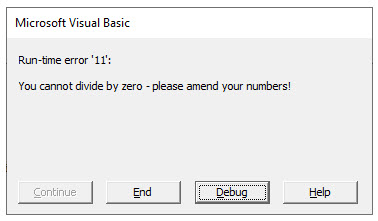

- Excel vba on error message box how to#
- Excel vba on error message box full#
- Excel vba on error message box code#
Unrecognized errors are redirected to the OtherError block. The ErrorHandler block in this case redirects to the designated error handler based on the Err.Number. based on the Error number see example below: If you want to handle multiple errors e.g. This statement is important to make sure the ErrorHandler is accessed only when an error is raised. Notice the Exit Sub statement just before the ErrorHandler label. If you want to handle all errors in a single section see example below:ĭebug.Print "Error number: " & Err.Number The below example shows how it is done: Single VBA error handler
Excel vba on error message box code#
The best practice for error handling is putting all handlers (jump labels) at the end of your code block – whether its a VBA Sub or Function. Now that we know our way around VBA error handling let’s learn some good practices on VBA error handling.
Excel vba on error message box full#
On MSDN you can find the full list of VBA errors.

On Error ĭirectly from MSDN we learn the different VBA error handling options we have with the On Error statement: Let’s remind the full syntax of the On Error statement in VBA first: It is like setting a mouse trap – with the difference that you can tell it to drop the mouse off the dumpster or put it in your hands to manage. The VBA On Error statement – tells VBA what it should do from now on, within the vicinity of the current block of code (Function or Sub), when an error/exception is raised. So what is our mouse trap when speaking about VBA error handling? The On Error do this statement! Using VBA On Error Obviously a better approach is setting mouse traps in several critical places in the house (corridors etc.) and waiting for the mouse to fall into your trap. Without knowing where the mouse is and when it (the exception/error) will appear (in which line of code) you would need to search entire house to catch it (run through the entire code in our case). What is error handling? Take this analogy: Say you have a mouse (an error) in the house which turns up every now and then in the least expected moment as slips from your hands (an uncaught exception if you prefer).
Excel vba on error message box how to#
No – today let’s learn how to properly handle errors The Mouse Trap Analogy However, today I don’t want to expand on debugging VBA.

Therefore, if you write the code as cleverly as possible, you are, by definition, not smart enough to debug it. Looking for errors is what developers do most of the time! A critical part of debugging is proper error handling (VBA error handling in our case).ĭebugging is twice as hard as writing the code in the first place. Sounds like non-sense? Well I dare say developers spend more time debugging code than writing it. Writing VBA code is hard, but properly debugging code is even harder.


 0 kommentar(er)
0 kommentar(er)
